Viola "palmata pseudo-stoneana"
Common names:
None.
Synonyms:
None.
Description:
Foliage and peduncles moderately to densely hirsute, green, margins of leaf blades ciliate; larger leaf blades deeply biternately divided into (5) 7 or 9 linear-lanceolate lobes, the terminal primary division divided just above the base into 2 linear-lanceolate suberect or strongly ascending to spreading (one on each side), the lateral primary divisions each deeply divided into 2–3 linear-lanceolate lobes or lunate to angulate, uncleft and merely toothed, sinuses between primary and lateral divisions reaching nearly to the petiole summit; calyx ciliate; lowest sepals in chasmogamous flower oblong-ovate to ovate and obtuse to rounded, in cleistogamous fruit broadly lanceolate and acuminate; cleistogamous capsule finely to heavily purple-spotted or blotched, on an initially prostrate peduncle arching upward abruptly just prior to dehiscence; seeds pale golden- or honey-yellow with small scarcely visible to weak yellow-brown streaks and blotches. Other features as in V. palmata.
Ecology:
Drier sandy or sandy loam soils in open dry to dry-mesic woodlands, often on steeper slopes.
Distribution:
Higher elevations of the Appalachian Mountains in the Ridge and Valley province, s.-c. PA south to w. NC and e. TN.
Rarity:
None.
Phenology:
Phenology presumably same as species.
Affinities:
This species belongs to the Acaulescent Blue Violet lineage, sect. Nosphinium W.Becker, subsect. Boreali-Americanae (W.Becker) Gil-ad, in the Palmata species group.
Hybrids:
Hybridizes with V. affinis (Hastings 2018, Harvey Ballard pers. comm.) and V. sororia sensu stricto (Hastings 2018, Harvey Ballard pers. comm.). We have observed that these exhibit intermediate or recombinant characteristics of foliage, chasmogamous flowers, cleistogamous capsules and seeds (where these did not abort). Studies of reproductive behavior are needed.
Comments:
This taxon is morphologically distinctive. It occurs sporadically along the central and southern Appalachian Mountains, based on herbarium specimens and on limited field studies in Pennsylvania and Virginia. The deeply biternate leaf blades vaguely recall those of V. stoneana but the insertion of the lateral lobes on the terminal primary division is subbasal rather than medial, and the present taxon has rather densely hirsute foliage (at least during chasmogamous flower) and other features similar to the accepted varieties of V. palmata. It shares biternate leaf blades with V. "palmata Red Hills" as well but mainly differs from that in the suberect to somewhat spreading lateral lobes on the terminal primary division of the leaf blade, chasmogamous flowers with shorter ovate-lanceolate to ovate obtuse sepals, cleistogamous fruits with broadly lanceolate acuminate sepals, and distribution at higher elevations in the Appalachian Mountains. Occasional plants lacking entire leaf blades could be confused with V. subsinuata, which also occurs in the same region and occasionally in the same area. The present taxon has a strong tendency (as other members of the V. palmata complex do) for the lateral primary divisions of some leaf blades to be lunate and remain uncleft or merely coarsely toothed, and the seeds are a pale golden- or honey-yellow ground color with scarcely to weakly visible yellow-brown streaks or blotches. Henry's (1953a) report of V. triloba var. dilatata from Allegheny County, Pennsylvania probably represents this taxon; a number of other herbarium specimens of the present taxon from west-central and montane areas of that state have been confirmed. Field studies by Jennifer Hastings (2018) have located a number of sites scattered along the Ridge and Valley province of western montane Virginia for this taxon. It is often found at the same sites with V. palmata var. triloba and V. subsinuata, and occasionally with V. monacanora; such mixed-species communities of diverse taxa with variously lobed leaf blades, plus their frequent hybrids with V. sororia and other entire-leaved species, has reasonaly led some taxonomists to treat all plants as one extensively polymorphic violet species (e.g., a heterogeneous and very broadly delimited V. palmata). Although surely more widely distributed than its sporadic Appalachian montane records suggest, the present taxon is poorly understood, since all plants have been dismissed as V. palmata var. dilatata. It has only recently been narrowly delineated and recognized as a potentially distinct taxon and needs further study. Studies of population samples from several Virginia localities demonstrate that hybridization with V. sororia is common, producing plants with leaf blades less deeply dissected and often less pronouncedly biternate, and seeds with a darker, yellow-brown or brown ground color and more prominent brown streaks.
Literature Cited:
Hastings, J. L. 2018. Systematic and ecological studies of the Viola subsinuata species complex. M.S. thesis. Ohio University, Athens, OH.
Henry, L. K. 1953a. The Violaceae in western Pennsylvania. Castanea 18(2): 37-59.
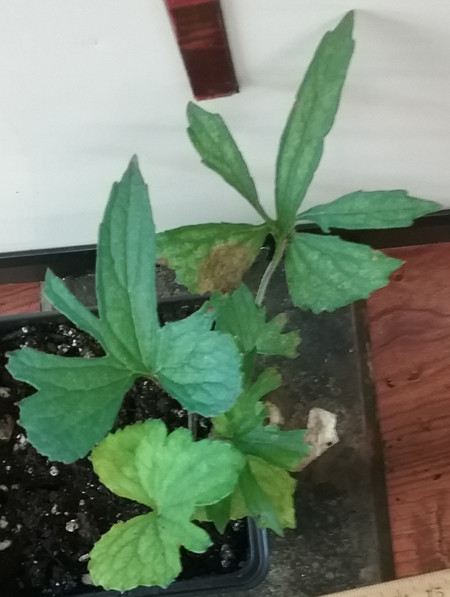
Cleistogamous fruiting habit of V. "palmata pseudo-stoneana" (transplanted plant from VA, Montgomery Co., Johnson Hill) by Jennifer Hastings
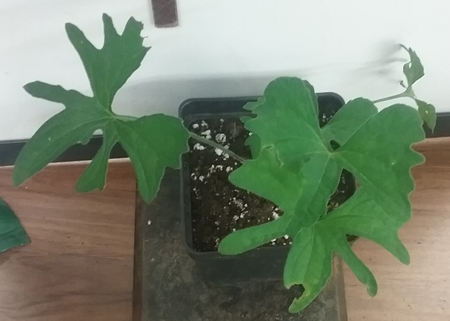
Cleistogamous fruiting habit (plant transplanted from VA, Bath Co., Douthat State Park) by Jennifer Hastings
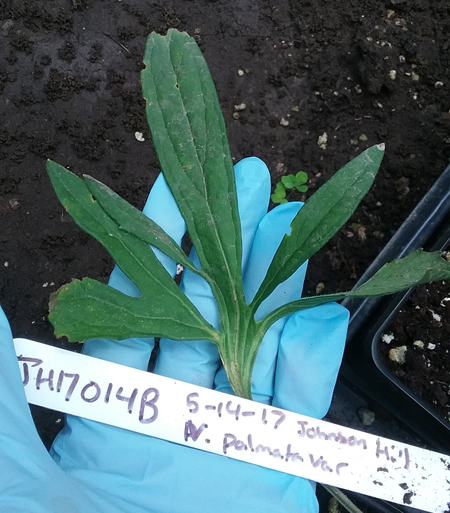
Leaf during cleistogamous fruit of V. "palmata pseudo-stoneana" (transplanted plant from VA, Montgomery Co., Johnson Hill) by Jennifer Hastings
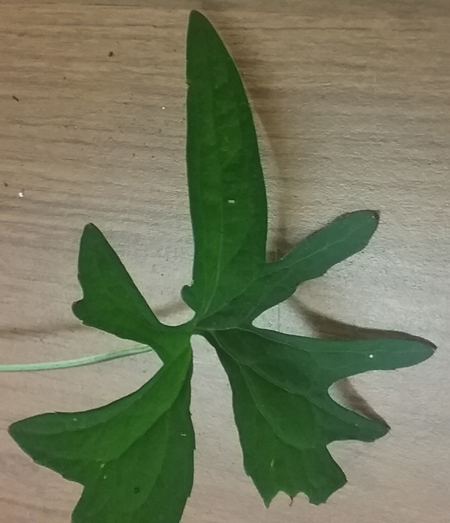
Leaf (plant transplanted from VA, Bath Co., Douthat State Park) by Jennifer Hastings

Chasmogamous flowers front and profile views (plant transplanted from VA, Bath Co., Douthat State Park) by Jennifer Hastings
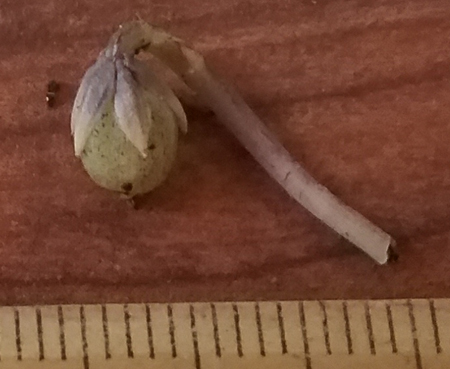
Cleistogamous fruit of V. "palmata pseudo-stoneana" (transplanted plant from VA, Montgomery Co., Johnson Hill) by Jennifer Hastings

Seeds of V. "palmata pseudo-stoneana" (transplanted plant from VA, Montgomery Co., Johnson Hill) by Jennifer Hastings
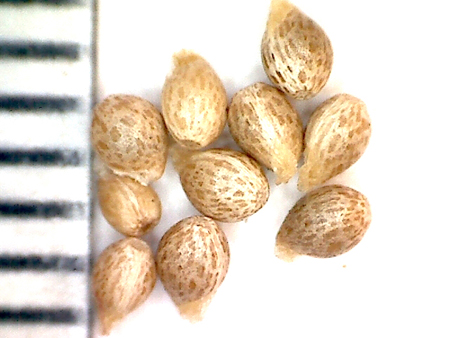
Seeds (plant transplanted from VA, Bath Co., Douthat State Park) by Jennifer Hastings
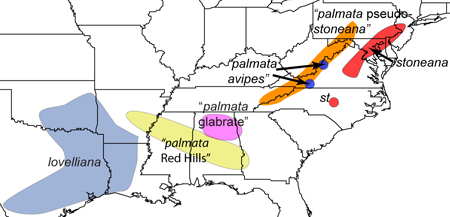
Map of regionally endemic taxa in the Palmata species group by Harvey Ballard